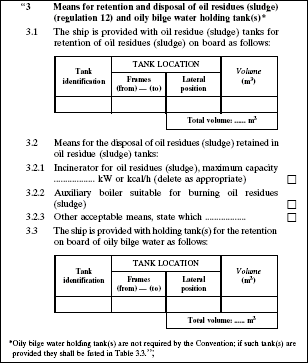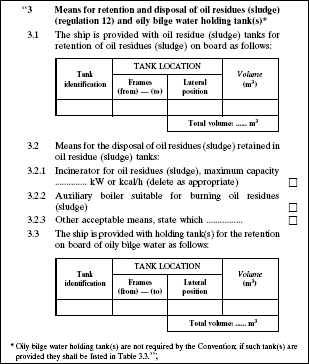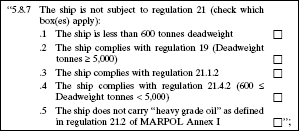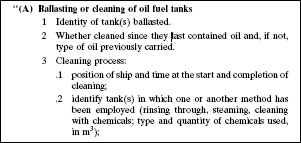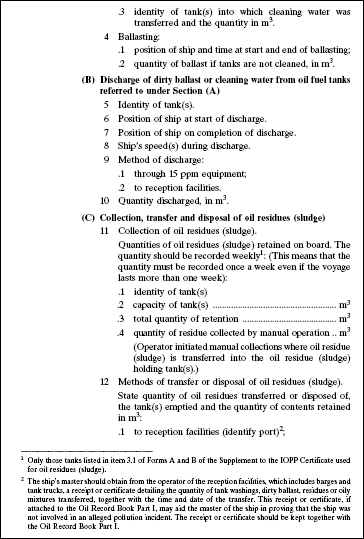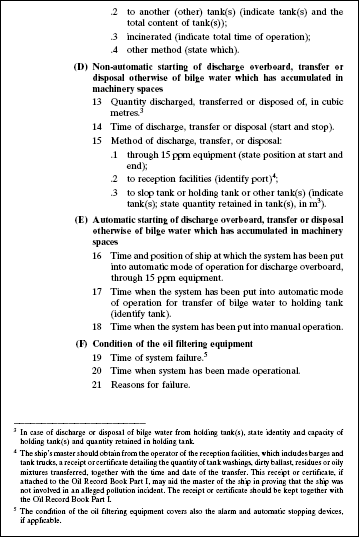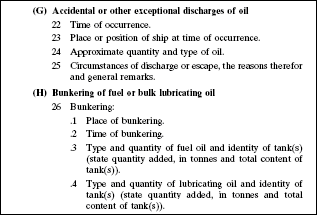5. The First Schedule to the principal Regulations is amended —| (a) | by inserting, immediately after paragraph 30 of regulation 1, the following paragraphs:| “31. Oil residue (sludge) means the residual waste oil products generated during the normal operation of a ship such as those resulting from the purification of fuel or lubricating oil for main or auxiliary machinery, separated waste oil from oil filtering equipment, waste oil collected in drip trays, and waste hydraulic and lubricating oils. |
| 32. Oil residue (sludge) tank means a tank which holds oil residue (sludge) from which sludge may be disposed directly through the standard discharge connection or any other approved means of disposal. |
| 33. Oily bilge water means water which may be contaminated by oil resulting from things such as leakage or maintenance work in machinery spaces. Any liquid entering the bilge system including bilge wells, bilge piping, tank top or bilge holding tanks is considered oily bilge water. |
| 34. Oily bilge water holding tank means a tank collecting oily bilge water prior to its discharge, transfer or disposal.”; |
|
| | (b) | by deleting paragraphs 1, 2 and 3 of regulation 12 and substituting the following paragraphs:| “1. Every ship of 400 gross tonnage and above shall be provided with a tank or tanks of adequate capacity, having regard to the type of machinery and length of voyage, to receive the oil residues (sludge) which cannot be dealt with otherwise in accordance with the requirements of this Annex. |
2. Oil residue (sludge) may be disposed of directly from the oil residue (sludge) tank(s) through the standard discharge connection referred to in regulation 13, or any other approved means of disposal. The oil residue (sludge) tank(s):| 1 shall be provided with a designated pump for disposal that is capable of taking suction from the oil residue (sludge) tank(s); and |
| 2 shall have no discharge connections to the bilge system, oily bilge water holding tank(s), tank top or oily water separators except that the tank(s) may be fitted with drains, with manually operated self-closing valves and arrangements for subsequent visual monitoring of the settled water, that lead to an oily bilge water holding tank or bilge well, or an alternative arrangement, provided such arrangement does not connect directly to the bilge piping system. |
|
| 3. Piping to and from oil residue (sludge) tanks shall have no direct connection overboard, other than the standard discharge connection referred to in regulation 13. |
| 4. In ships delivered after 31 December 1979, as defined in regulation 1.28.2, tanks for oilresidues shall be designed and constructed so as to facilitate their cleaning and the discharge of residues to reception facilities. Ships delivered on or before 31 December 1979, as defined in regulation 1.28.1, shall comply with this requirement as far as is reasonable and practicable.”; |
|
| | (c) | by deleting the word “sludge” in regulation 13 and substituting the words “oil residue (sludge)”; | | (d) | by deleting the words “sludge and other oil residues” in paragraph 2.3 of regulation 17 and substituting the words “oil residue (sludge)”; | | (e) | by deleting the word “sludge” in paragraphs 2.4, 7.1 and 7.2 of regulation 38 and substituting in each case the words “oil residue (sludge)”; | | (f) | by inserting, immediately after regulation 39, the following chapter:Prevention of Pollution During
Transfer of Oil Cargo Between
Oil Tankers At Sea |
| Regulation 40 — Scope of application |
|
| 1.The regulations contained in this chapter apply to oil tankers of 150 gross tonnage and above engaged in the transfer of oil cargo between oil tankers at sea (STS operations) and their STS operations conducted on or after 1 April 2012. However, STS operations conducted before that date but after the approval of the Administration of STS operations Plan required under regulation 41.1 shall be in accordance with the STS operations Plan as far as possible. |
2.The regulations contained in this chapter shall not apply to oil transfer operations associated with fixed or floating platforms including drilling rigs; floating production, storage and offloading facilities (FPSOs) used for the offshore production and storage of oil; and floating storage units (FSUs) used for the offshore storage of produced oil1.| 1 Revised Annex I of MARPOL, chapter 7 (resolution MEPC.117(52)) and UNCLOS article 56 are applicable and address these operations. |
|
| 3.The regulations contained in this chapter shall not apply to bunkering operations. |
| 4.The regulations contained in this chapter shall not apply to STS operations necessary for the purpose of securing the safety of a ship or saving life at sea, or for combating specific pollution incidents in order to minimize the damage from pollution. |
| 5.The regulations contained in this chapter shall not apply to STS operations where either of the ships involved is a warship, naval auxiliary or other ship owned or operated by a State and used, for the time being, only on government non-commercial service. However, each State shall ensure, by the adoption of appropriate measures not impairing operations or operational capabilities of such ships that the STS operations are conducted in a manner consistent, so far as is reasonable and practicable, with this chapter. |
|
Regulation 41 — General rules on safety and
environmental protection |
|
| 1.Any oil tanker involved in STS operations shall carry on board a Plan prescribing how to conduct STS operations (STS operations Plan) not later than the date of the first annual, intermediate or renewal survey of the ship to be carried out on or after 1 January 2011. Each oil tanker’s STS operations Plan shall be approved by the Administration. The STS operations Plan shall be written in the working language of the ship. |
2.The STS operations Plan shall be developed taking into account the information contained in the best practice guidelines for STS operations identified by the Organization2. The STS operations Plan may be incorporated into an existing Safety Management System required by chapter IX of the International Convention for the Safety of Life at Sea, 1974, as amended, if that requirement is applicable to the oil tanker in question.| 2 IMO’s “Manual on Oil Pollution, Section I, Prevention” as amended, and the ICS and OCIMF “Ship-to-ship Transfer Guide, Petroleum”, fourth edition, 2005. |
|
| 3.Any oil tanker subject to this chapter and engaged in STS operations shall comply with its STS operations Plan. |
4.The person in overall advisory control of STS operations shall be qualified to perform all relevant duties, taking into account the qualifications contained in the best practice guidelines for STS operations identified by the Organization3.| 3 Revised Annex I of MARPOL chapters 3 and 4 (resolution MEPC.117(52)); requirements for recording bunkering and oil cargo transfer operations in the Oil Record Book, and any records required by the STS operations Plan. |
|
5.Records4 of STS operations shall be retained on board for three years and be readily available for inspection by a Party to the present Convention.| 4 IMO’s “Manual on Oil Pollution, Section I, Prevention” as amended, and the ICS and OCIMF “Ship-to-ship Transfer Guide, Petroleum”, fourth edition, 2005. |
|
|
| Regulation 42 — Notification |
|
| 1.Each oil tanker subject to this chapter that plans STS operations within the territorial sea, or the exclusive economic zone of a Party to the present Convention shall notify that Party not less than 48 hours in advance of the scheduled STS operations. Where, in an exceptional case, all of the information specified in paragraph 2 is not available not less than 48 hours in advance, the oil tanker discharging the oil cargo shall notify the Party to the present Convention, not less than 48 hours in advance that an STS operation will occur and the information specified in paragraph 2 shall be provided to the Party at the earliest opportunity. |
2.The notification specified in paragraph 1 of this regulation5 shall include at least the following:| 5 The national operational contact point as listed in document MSC-MEPC.6/Circ.4 of 31 December 2007 or its subsequent amendments. |
| 1 | name, flag, call sign, IMO Number and estimated time of arrival of the oil tankers involved in the STS operations; | | 2 | date, time and geographical location at the commencement of the planned STS operations; | | 3 | whether STS operations are to be conducted at anchor or underway; | | 4 | oil type and quantity; | | 5 | planned duration of the STS operations; | | 6 | identification of STS operations service provider or person in overall advisory control and contact information; and | | 7 | confirmation that the oil tanker has on board an STS operations Plan meeting the requirements of regulation 41. |
|
| 3.If the estimated time of arrival of an oil tanker at the location or area for the STS operations changes by more than six hours, the master, owner or agent of that oil tanker shall provide a revised estimated time of arrival to the Party to the present Convention specified in paragraph 1 of this regulation.”; |
|
|
|
| | (g) | by deleting paragraph 3 of Form A (relating to “RECORD OF CONSTRUCTION AND EQUIPMENT FOR SHIPS OTHER THAN OIL TANKERS”) in Appendix II and substituting the following paragraph: | | (h) | by deleting paragraph 3 of Form B (relating to “RECORD OF CONSTRUCTION AND EQUIPMENT FOR OIL TANKERS”) in Appendix II (referred to in these Regulations as Form B) and substituting the following paragraph: | | (i) | by deleting the words “(double bottom requirements)” in paragraph 5.8.2 of Form B; | | (j) | by deleting paragraph 5.8.5 of Form B and substituting the following paragraph: | | (k) | by deleting paragraph 5.8.7 of Form B and substituting the following paragraph: | | (l) | by deleting sub-paragraph .4 of paragraph 6.1.5 of Form B; | | (m) | by inserting, immediately after paragraph 8 of Form B, the following paragraph: | | (n) | by deleting sections (A) to (H) in Part I of Appendix III and substituting the following sections: | | (o) | by deleting sections (A) to (R) in Part II of Appendix III and substituting the following sections:| “(A) Loading of oil cargo(B) Internal transfer of oil cargo during voyage(C) Unloading of oil cargo(D) Crude oil washing (COW tankers only)(E) Ballasting of cargo tanks(F) Ballasting of dedicated clean ballast tanks (CBT tankers only)(G) Cleaning of cargo tanks(H) Discharge of dirty ballast(I) Discharge of water from slop tanks into the sea(J) Collection, transfer and disposal of residues and oily mixtures not otherwise dealt with(K) Discharge of clean ballast contained in cargo tanks(L) Discharge of ballast from dedicated clean ballast tanks (CBT tankers only)(M) Condition of oil discharge monitoring and control system(N) Accidental or other exceptional discharges of oil(O) Additional operational procedures and general remarks(P) Loading of ballast water(Q) Re-allocation of ballast water within the ship(R) Ballast water discharge to reception facility |
| “(1) | Place of loading. | | (2) | Type of oil loaded and identity of tank(s). | | (3) | Total quantity of oil loaded (state quantity added, in m3 at 15°C and the total content of tank(s), in m3). | | (4) | Identity of tank(s):| 1 | from: | | 2 | to: (state quantity transferred and total quantity of tank(s), in m3). |
| | (5) | Was (were) the tank(s) in 4.1 emptied? (If not, state quantity retained, in m3.) | | (6) | Place of unloading. | | (7) | Identity of tank(s) unloaded. | | (8) | Was (were) the tank(s) emptied? (If not, state quantity retained, in m3.) |
(To be completed for each tank being crude oil washed) | (9) | Port where crude oil washing was carried out or ship’s position if carried out between two discharge ports. | | (10) | Identity of tank(s) washed.6| 6 When an individual tank has more machines than can be operated simultaneously, as described in the Operations and Equipment Manual, then the section being crude oil washed should be identified, e.g. No.2 centre, forward section. |
| | (11) | Number of machines in use. | | (12) | Time of start of washing. | | (13) | Washing pattern employed.7| 7 In accordance with the Operations and Equipment Manual, enter whether single-stage or multi-stage method of washing is employed. If multi-stage method is used, give the vertical arc covered by the machines and the number of times that arc is covered for that particular stage of the programme. |
| | (14) | Washing line pressure. | | (15) | Time washing was completed or stopped. | | (16) | State method of establishing that tank(s) was (were) dry. | | (17) | Remarks.8| 8 If the programmes given in the Operations and Equipment Manual are not followed, then the reasons must be given under Remarks. |
| | (18) | Position of ship at start and end of ballasting. | | (19) | Ballasting process:| 1 | identity of tank(s) ballasted; | | 2 | time of start and end; and | | 3 | quantity of ballast received. Indicate total quantity of ballast for each tank involved in operation, in m3. |
| | (20) | Identity of tank(s) ballasted. | | (21) | Position of ship when water intended for flushing, or port ballast was taken to dedicated clean ballast tank(s). | | (22) | Position of ship when pump(s) and lines were flushed to slop tank. | | (23) | Quantity of the oily water which, after line flushing, is transferred to the slop tank(s) or cargo tank(s) in which slop is preliminarily stored (identify tank(s)). State total quantity, in m3. | | (24) | Position of ship when additional ballast water was taken to dedicated clean ballast tank(s). | | (25) | Time and position of ship when valves separating the dedicated clean ballast tanks from cargo and stripping lines were closed. | | (26) | Quantity of clean ballast taken on board, in m3. | | (27) | Identity of tank(s) cleaned. | | (28) | Port or ship’s position. | | (29) | Duration of cleaning. | | (30) | Method of cleaning.9| 9 Hand-hosing, machine washing and/or chemical cleaning. Where chemically cleaned, the chemical concerned and amount used should be stated. |
| | (31) | Tank washings transferred to:| 1 | reception facilities (state port and quantity, in m3)10; and| 10 Ships’ masters should obtain from the operator of the reception facilities, which include barges and tank trucks, a receipt or certificate detailing the quantity of tank washings, dirty ballast, residues or oily mixtures transferred, together with the time and date of the transfer. This receipt or certificate, if attached to the Oil Record Book Part II, may aid the master of the ship in proving that his ship was not involved in an alleged pollution incident. The receipt or the certificate should be kept together with the Oil Record Book Part II. |
| | 2 | slop tank(s) or cargo tank(s) designated as slop tank(s) (identify tank(s); state quantity transferred and total quantity, in m3). |
| | (32) | Identity of tank(s). | | (33) | Time and position of ship at start of discharge into the sea. | | (34) | Time and position of ship on completion of discharge into the sea. | | (35) | Quantity discharged into the sea, in m3. | | (36) | Ship’s speed(s) during discharge. | | (37) | Was the discharge monitoring and control system in operation during the discharge? | | (38) | Was a regular check kept on the effluent and the surface of the water in the locality of the discharge? | | (39) | Quantity of oily water transferred to slop tank(s) (identify slop tank(s). State total quantity, in m3.) | | (40) | Discharged to shore reception facilities (identify port and quantity involved, in m3).11| 11 Ships’ masters should obtain from the operator of the reception facilities, which include barges and tank trucks, a receipt or certificate detailing the quantity of tank washings, dirty ballast, residues or oily mixtures transferred, together with the time and date of the transfer. This receipt or certificate, if attached to the Oil Record Book Part II, may aid the master of the ship in proving that his ship was not involved in an alleged pollution incident. The receipt or the certificate should be kept together with the Oil Record Book Part II. |
| | (41) | Identity of slop tanks. | | (42) | Time of settling from last entry of residues, or | | (43) | Time of settling from last discharge. | | (44) | Time and position of ship at start of discharge. | | (45) | Ullage of total contents at start of discharge. | | (46) | Ullage of oil/water interface at start of discharge. | | (47) | Bulk quantity discharged, in m3 and rate of discharge, in m3/hour. | | (48) | Final quantity discharged, in m3 and rate of discharge, in m3/hour. | | (49) | Time and position of ship on completion of discharge. | | (50) | Was the discharge monitoring and control system in operation during the discharge? | | (51) | Ullage of oil/water interface on completion of discharge, in metres. | | (52) | Ship’s speed(s) during discharge. | | (53) | Was a regular check kept on the effluent and the surface of water in the locality of the discharge? | | (54) | Confirm that all applicable valves in the ship’s piping system have been closed on completion of discharge from the slop tanks. | | (55) | Identity of tanks. | | (56) | Quantity transferred or disposed of from each tank. (State the quantity retained, in m3.) | | (57) | Method of transfer or disposal:| 1 | disposal to reception facilities (identify port and quantity involved); | | 2 | mixed with cargo (state quantity); | | 3 | transferred to or from (an)other tank(s) including transfer from machinery space oil residue (sludge) and oily bilge water tanks (identify tank(s); state quantity transferred and total quantity in tank(s), in m3); and | | 4 | other method (state which); state quantity disposed of in m3. |
| | (58) | Position of ship at start of clean ballast. | | (59) | Identity of tank(s) discharged. | | (60) | Was (were) the tank(s) empty on completion? | | (61) | Position of ship on completion if different from 58. | | (62) | Was a regular check kept on the effluent and the surface of the water in the locality of the discharge? | | (63) | Identity of tank(s) discharged. | | (64) | Time and position of ship at start of discharge of clean ballast into the sea. | | (65) | Time and position of ship on completion of discharge into the sea. | | (66) | Quantity discharged, in m3:| 1 | into the sea; or | | 2 | to reception facility (identify port).12| 12 Ships’ masters should obtain from the operator of the reception facilities, which include barges and tank trucks, a receipt or certificate detailing the quantity of tank washings, dirty ballast, residues or oily mixtures transferred, together with the time and date of the transfer. This receipt or certificate, if attached to the Oil Record Book Part II, may aid the master of the ship in proving that his ship was not involved in an alleged pollution incident. The receipt or the certificate should be kept together with the Oil Record Book Part II. |
|
| | (67) | Was there any indication of oil contamination of the ballast water before or during discharge into the sea? | | (68) | Was the discharge monitored by an oil content meter? | | (69) | Time and position of ship when valves separating dedicated clean ballast tanks from the cargo and stripping lines were closed on completion of deballasting. | | (70) | Time of system failure. | | (71) | Time when system has been made operational. | | (72) | Reasons for failure. | | (73) | Time of occurrence. | | (74) | Port or ship’s position at time of occurrence. | | (75) | Approximate quantity, in m3, and type of oil. | | (76) | Circumstances of discharge or escape, the reasons therefor and general remarks. |
TANKERS ENGAGED IN SPECIFIC TRADES | (77) | Identity of tank(s) ballasted. | | (78) | Position of ship when ballasted. | | (79) | Total quantity of ballast loaded in cubic metres. | | (80) | Remarks. | | (81) | Reason for re-allocation. | | (82) | Port(s) where ballast water was discharged. | | (83) | Name or designation of reception facility. | | (84) | Total quantity of ballast water discharged in cubic metres. | | (85) | Date, signature and stamp of port authority official.”. |
|
|
|

